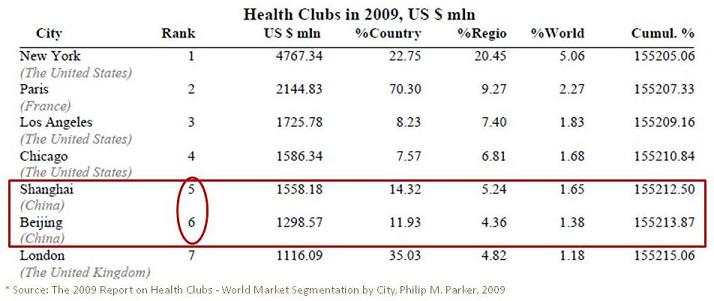As China has become the 2nd largest economy in the world and 11.3% of the nation’s households have reached middle class level with an average annual income of RMB40,000-200,000 (US$6,000-30,000), more and more Chinese have been aware of the importance of well-being and fitness. The health club market has since become huge in China now.
With the Chinese middle class population keeping fast growth, 44% increase per year since 2008, it is foreseeable that the health club market will have great potential in China.
However, compared with those developed markets, the health club business in China is still very immature with many of the players struggling to survive. Now let’s take a close look at the market landscape.
China Health Club Market Overview
As of 2010, China has about 3,000 health clubs, with about 3 million active members, annual membership fee mainly range from RMB 600 yuan (US$ 91) to 5,000 yuan (US$ 762).
Geographically the market is highly concentrated. Up to now most health clubs in China are in 1st and 2nd-tier cities, very few in 3rd-tier cities. Beijing and Shanghai have far more clubs than other cities. But fitness markets in western China have shown robust growth in recent years, as the government encourages economic development in its “Go West” policy.
Currently, commercial gyms dominate the Chinese market with about 86% of the total number of fitness centers. Hotel gyms comprise about 10% of the market, while public gyms lag well behind in terms of expansion into the market.
History Background
When the Chinese health and fitness industry took off on a grand scale in the early 2000s, the focus was on Beijing and Shanghai. Residents of these cities have higher incomes and are generally more health conscious than those in other parts of the country.
In 1995, the Chinese government launched its “Nationwide Physical Fitness Program”. Over a decade later, the Beijing Olympics galvanized people to take up physical activity in the face of a growing obesity problem caused by rising wealth, changes in diet, and increasingly sedentary lifestyles. White-collar workers now recognize the importance of exercise and fitness. These factors should spell success for a well-run commercial gym but, in reality, many gyms are in trouble. Short-term cash flow is prioritized over member retention.
Some gym chains have been expanding rapidly in the hope that scale will translate into success. The number of gyms operated by the top five fitness chains in China increased by 35%, year on year, in 2008.
Main Players Overview
The two largest gym chains in China: Tera Wellness and Hosa Fitness were founded by entrepreneurs from China mainland and Hongkong. Tera Wellness is based in Shanghai, while Hosa is based in Beijing.
International gym chains: Most have struggled to find their place in the market. However, Bally and Powerhouse Gyms, the largest international brand players in the China market by number of sites, are the exceptions. The former is a Chinese majority-owned joint venture, and the latter is owned by a Chinese master franchisee.
California Fitness, which arguably revolutionized the commercial gym market in Hong Kong when it launched in 1997, only has two centers in China. Fitness First, another big global player, withdrew from the Shanghai market altogether, leaving it with a single centre (operated under a different name) in Beijing. Gold’s Gym also had a brief and unsuccessful foray into the China market in Shanghai.
Regional gym chains: They have so far in a better situation than most international ones. Alexander Health Group from Taiwan, known as “Alexander City Club” in Mainland China, occupied its own space and had a clear brand proposition. However, the company sold its Mainland China operations prior to a spectacular collapse in Taiwan. Megafit is run by a Hong Kong company with an operations base in Shenzhen.
Private equity firms have been investors in Chinese gyms and those around the region. Temasek, an investment company owned by the Singapore Government invested in Tera Wellness. Will’s Gym, based in Shanghai, has also benefited. However, the majority of the funds have come from other sources in the Mainland China market.
 Tera Wellness was founded in Shanghai in 2001. It is so far the largest health club chain in China with nearly 100 gym locations over 13 cities, 44 of its existing locations are in Shanghai. According to its official announcement, it will expand to 200 locations by 2011.
Tera Wellness was founded in Shanghai in 2001. It is so far the largest health club chain in China with nearly 100 gym locations over 13 cities, 44 of its existing locations are in Shanghai. According to its official announcement, it will expand to 200 locations by 2011.
In 2007 Tera Wellness acquired a $20M investment from Temasek, an investment company owned by the Singapore Government.
Currently, Tera Wellness has over 3,000 employees in China.
Hosa Fitness was founded in Hongkong and currently based in Beijing. It acquired the Beijing based Hokay Fitness’s total 51 clubs in 2009 and became one of the top two players in China’s health club market.
Currently it has about 70 locations across 7 cities in China, 36 of the locations are in Beijing.
Huge Market Potential
According to INSEAD chaired professor Philip M. Parker’s research report on world health club market published with Icon Group International in 2009:
China’s Shanghai and Beijing have the world’s No. 5 and No. 6 health club market potential/latent demand among all cities globally in 2009.
But the reality is that for Chinese cities like Shanghai and Beijing, the actual health club market revenue is far lower than the potential demand yet and many gyms are in trouble.
There are two main reasons.
1. It is still a long way to go for most Chinese citizens to take fitness as a regular part of their daily life. Although there is an increasing awareness of well-being and fitness, there is still a large gap between the awareness and the action. In a word, like any other change, the lifestyle change in the 1.3 billion population nation takes time and inspiration and education are needed to speed up the change.
2. Most gyms are having problems in management strategies and operation. According to Deloitte’s research report on the health and fitness market in China in 2009:
“Many gyms are in trouble, chasing short-term cash flow and churning members. All too often in China, the default tactic for attracting members is to compete and differentiate on price. This may bring short-term gains, but in the long-term damages the revenue model and erodes both brand equity and member loyalty. Some gym chains have been expanding rapidly in the hope that scale will be the key to success, although this may only exacerbate any underlying flaws in their business model. In fact, the number of gyms operated by the top five fitness chains in China increased by 35% year-on-year in 2008. Consumers now have many more choices than they ever did before. To survive in the long-term, gym operators need to re-think their business model in order to attract and retain members.”
In the report, Deloitte pointed out 7 critical points for health clubs in China to reach the long-term success:
• Low retention is having a significant impact on profits
• Existing business models need to change — no matter how reluctant they may be, gyms need to begin adopting a monthly-payment model. Sales of multi-year/lifetime memberships must end
• Gyms must compete on more than just price
• In the Top 10 cities, gym operators must respond to customer demand, as members now have
more choice of fitness centres
• “Network effects” between sites are critical as changing lifestyles mean travel time is a deciding issue
• Marketing must improve — word of mouth is an important driver, as a majority of Chinese members
go the gym with someone; local area marketing appears limited
• Service quality still needs to improve
Follow China Sports Business on Twitter @SportsBizChina
To contact the reporter/editor for this story: Carrie Xu, USC Marshall MBA 2011 in Los Angeles at Yanqin.Xu.2011@marshall.usc.edu
To subscribe to the blog, enter your email address at right of the home page.
Copyright © 2011 ChinaSportsBiz.com


Beware of Tera Wellness. Their sales people would say anything and promise you anything, but when you ask them to put their oral promises and guarantees in the contract, they would say they spoke too fast that day and those couldn’t be done. One I came across even asked me in return “if I didn’t say it this way, wouldn’t you not sign up for the membership”? Luckily I haven’t signed their membership consent contract, which states something like once you have paid and signed this document, your money is non-refundable. And for those of you who do not believe me, just try going to their website, look up for the complain hotline and call. You would be lucky if someone actually picks up the phone and speak to you! If you can read Chinese or know someone who does, just go google or baidu for this gym and you will be surprised on how unsatisfied most of its members are.
Posted by hftan | July 21, 2011, 2:26 amThank you HFTAN. I appreciate your sharing. Yeah, nowadays many of the gyms in China focus too much on the short-term cash flow at the expense at the long term brand building. Part of the reason is because most of them are struggling financially. Personally I feel sad for them, and I hope the situation will change in the near future.
Posted by Yanqin Xu | July 22, 2011, 8:34 pm